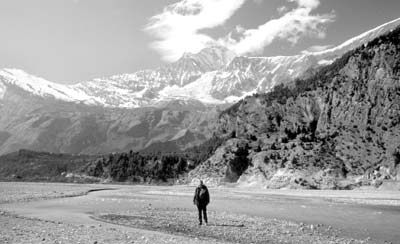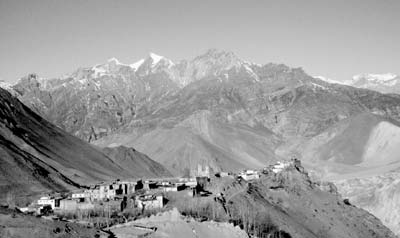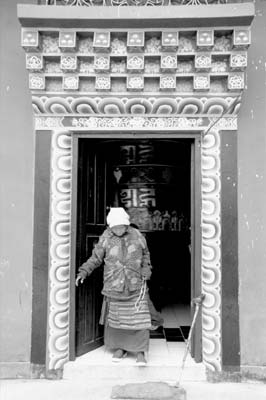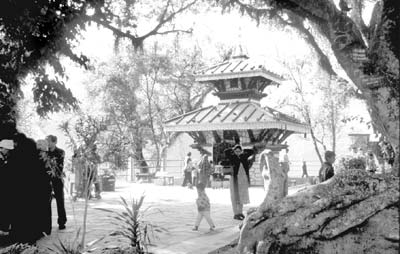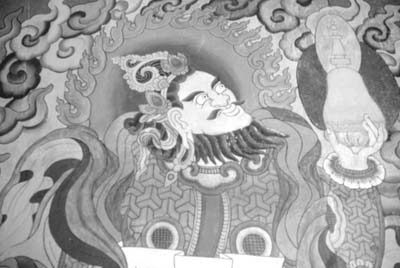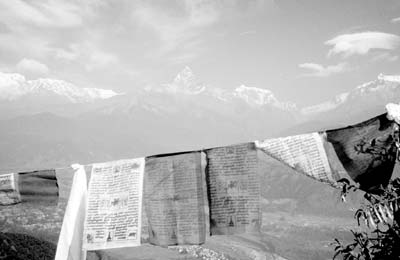Nepal — hiking the Annapurna Circuit
by Steven Cole, Lowell, MI (First of two parts, jump to part 2)
“It seems like yesterday. . .” is a phrase older folks find themselves saying quite often. For me, it seems like yesterday that I was taking stairs two at a time. Now I avoid stairs whenever I can. But in January ’06 I had an opportunity to ascend the world’s biggest “staircase” — in the Himalayas.
I was going to Pokhara, Nepal, as a consultant on a U.S. aid project and would have sufficient free time for a trek, but I kept wondering whether a person over 60 could manage even moderate hiking in the world’s highest mountains. And, out of necessity, I wondered if a trek could be done on a tight budget. I’m happy to report that the answer to both questions is “Yes.”
Setting out
Pokhara is the main starting point for treks along the Annapurna Circuit, which leads trekkers among awesome mountains including Annapurna, several subsidiary Annapurnas, Nilgiri, Dhaulagiri and Machhapuchhare. Many of the peaks are visible from Pokhara’s streets.
The entire circuit takes more than two weeks and I didn’t have that much time. Instead, I opted to spend five days in the Mustang district near the Tibetan border, an area I had dreamed of visiting since reading French ethnologist Michel Peissel’s thrilling book, “Mustang, the Forbidden Kingdom,” in 1967.
I was also highly interested in the area because in the early ’60s Tibetan freedom fighters trained by the CIA hid in the district, then a semiautonomous principality, to plan raids on Chinese army posts over the border in occupied Tibet.
From Pokhara I flew in an aging 20-seat plane north to the small town of Jomsom, which has the only regularly operating airstrip on the circuit.
I had rented a backpack in Pokhara but wondered if I could carry it in the thin mountain air. Thankfully, I found a cheerful young man in Jomsom named Karna to porter it for a mere $7 a day. He also served as guide, although the trail is obvious and a guide is not essential.
Incredible views
This part of the circuit follows the bed of the Kali Gandaki, one of the world’s great rivers. The ideal trekking season is in the fall, when the majestic half-mile-wide river is in full flow and the weather is often perfect. In January the flow was greatly reduced, but it was still mostly sunny and temperatures ranged from freezing at night to the mid-60s in the afternoon.
The trail follows the banks of the river, and huge foothills backed by mountains over 20,000 feet tower over the canyon. Mustang is on the edge of the great Tibetan plateau and is mostly treeless. Thus the landscape is awesome, not so much in terms of alpine beauty as in its immenseness. Against such a background, people and animals look like dots until they are only a few yards away.
Unfortunately, the view is often marred by power lines, which the art director of “A Nepalese Journey” by Andrew Stevenson removed from this otherwise very good picture book of the circuit.
The terrain
No one I spoke with could provide information on distances, only average walking times. Since I have gout, which sometimes results in painful foot swelling, and occasional mild arthritis in my knees, I worried if I could hold out, but I did! My pedometer told me I walked 47 miles in five days.
The trail is loose gravel, mostly flat or gently rising and fairly wide. However, in the low-water season it is shorter to walk in the partly dry riverbed, which is packed with smooth, round stones the size of melons. I was glad to have a pair of well-broken-in boots with heavy soles.
There are no medical personnel in the area and an evacuation could take days, so persons with heart conditions or other medical threats should beware.
The first day, Karna and I hiked south along the river to Tukuche, the three peaks of Nilgiri to our left. The first hotel I spotted was the High Plains Inn (Tukuche, Mustang District, Nepal; www. highplainsinn.com), run by a young Dutchman, Patrick Maas.
Patrick’s hotel was immaculate, but that cannot be said for other hotels along the route. My room was priced at $7 in low season, $10 in high season.
Accommodation
Surprisingly, almost all of the hotels in the villages that dot the route had bathrooms with flush toilets, but most had ancient fixtures that looked like they hadn’t been cleaned in years. Many hotels charged $3 to $4 a night, one a mere $1.50.
Patrick laughed about the fact that many tourists think that booking a tour guarantees first-class accommodations. There is only one level of hotel on the circuit, and to be kind I’ll call it “budget.”
While Patrick prepared an excellent spaghetti dinner for me, other hotels pawned off bad interpretations of Western food or the Nepalese national dish, dal bhat, a watery lentil soup accompanied by rice, a cup of chicken curry often containing tiny bone fragments and vegetables.
After a couple of bad meals and having peered into several frightfully dirty hotel kitchens, I sustained myself on canned luncheon meat and candy bars. Considering how busy the trail can be in the high tourist season, there is surprisingly little food available for self-catering, although bottled water is available everywhere.
Some steep hiking
Half a day’s walk south of Tukuche I came to Larjung, where 26,810-foot Dhaulagiri rises splendidly beside the river. This sight alone made the trip worth it.
I retraced my steps north and stopped in Marpha, the apple capital of Nepal, where small orchards line the trail. North, past Jomsom and on to Kagbeni, the trail ascends and follows a sheer drop of hundreds of feet to the rushing river below.
From a distance, Kagbeni evokes visions of the mythical Shangri-la. The chief tourist site is a fascinating old Buddhist temple decorated with elaborate scenes of gods and demons.
Hiking any part of the Annapurna circuit requires a permit costing $30. To travel past Kagbeni to the area’s most remote village, Peissel’s goal of Lo Manthang, inexplicably costs an additional $700! Not wanting to pay the fee, I turned east and followed the Jo hong Khola, a tributary of the Kali Gandaki.
This is the only leg of my trek where there were any steep, though manageable, sections. The landscape reminded me of hiking in the Grand Canyon.
Soon I reached the picturesque, though filthy, village of Jharkot. Here an ancient temple was closed, but its outer walls were covered by more colorful Buddhist imagery.
I hiked on to Muktinath, at 12,168 feet. From there you can hike over the 17,764-foot Thorong La pass and around behind the Annapurna range, but this is not advisable in winter so I returned to Jomsom and flew down to Pokhara for some much-needed R&R.
Pokhara
A 25-minute flight west of Kathmandu, Pokhara nestles beside a large lake ringed by huge forested foothills, making it a popular resort for Nepalese escaping the summer heat in the capital.
To the north, the Annapurna range rises behind the foothills, creating a spectacular backdrop for the town. The town folks’ favorite peak is Machhapuchhare, at nearly 23,000 feet. It is said to look like a fishtail, a resemblance I couldn’t see.
Most foreigners come to Pokhara for serious trekking. But if you’re not up to hiking, there’s still plenty to do in the area, including short trips out of town for a closer view of the mountains.
For example, a 45-minute, $10 taxi ride takes you to the top of Sarangkot, a 5,200-foot “hill” that provides stunning views of Annapurna, Annapurna South, Annapurnas II, III and IV, Hiunchuli and Machhapuchhare.
Other outdoor options
The Nepalese, however, are used to seeing mountains over 20,000 feet, so they tend to congregate at Phewa (or Fewa) Lake. Some people swim in the lake, but there are no beaches. Boating is extremely popular, and rowboats painted in bright primary colors can be rented for about a dollar an hour or $2 with a boatman to do the rowing.
Just off shore is a small island with an interesting Hindu temple that is popular with visitors, and directly across the lake, atop a huge hill, is the World Peace Pagoda, a Buddhist stupa whose peak can be seen from the lake below.
On a nice day you’ll see paragliders drifting down from the foothills to land on the lakeshore. Several agencies rent paragliding equipment and can arrange a trip to the launch spot for about $85. There are also international paragliding competitions here.
Where to stay
All of the action in Pokhara is in “Lakeside,” a mile-and-a-half stretch of road on the east side of the lake jammed with shops, restaurants and hotels. Oddly, there are few hotels on the lake side of the street, and those on the opposite side offer lake views only from the upper floors.
However, one new hotel, Peace Plaza (cpc@fewanet.com.np), located on the lake side, has pleasant balconies overlooking the water. The owner, desperate for business due to the off-season and a Maoist scare, offered me a room for $6.
But I was committed to a stay at Base Camp Resort (Lake Side, Pokhara 6, Nepal; www.basecampresort.com), where I paid $23 a night including tax. My room had about the comfort level of a 1970s motel in the U.S. but was more than adequate.
Pokhara’s main drag is exciting and colorful, thronged with Nepalese and Tibetans — many in native dress — plus Japanese and Korean tourists and tall blond Europeans in clunky hiking boots, all sidestepping meandering cows and their droppings.
Where to eat plus a bit of shopping
Pokhara has tuned in to exactly what many foreign visitors want, and nowhere is this more apparent than in restaurants that serve surprisingly accurate versions of foreign dishes, from Mexican and Italian to German, Turkish and Chinese cuisine.
In the Lakeside area, I returned often to Caffè Concerto, which served some of the best pizza ($3) I’ve had anywhere. At Laxman Restaurant I enjoyed a local specialty, “rum steak,” a grilled steak flambéed with rum, topped with cheese and served with excellent French fries and a salad of lettuce and tomatoes which, the menu informed me, had been washed in purified water (around $5 for the meal).
Lakeside also contains a large number of tiny, gaily painted barber stalls which offer partial- or full-body massages. It cost a mere $1.50 to have my trail-weary feet massaged for 15 minutes.
But the main attraction along this street is the shops crammed with exotic goods, particularly jewelry, masks, marionettes, prayer wheels, incense burners, paintings on cloth and wood, and Buddhist statuary made by the area’s Tibetan refugees.
Other shops specialize in beautiful shawls made from pashmina, the undercoat of a mountain goat. Still others sell embroidered clothing, cushions, paper goods, CDs of Nepalese and Tibetan music, Nepalese tea and khukuris, the traditional knives of Nepal’s famous Gurkha soldiers.
Bargaining is expected, and sellers start by asking two to three times the price you’ll end up paying. I bought several pieces of jewelry for $2 to $7, shawls for $3 to $8 and masks for $2 to $3, with many art objects under $20. Exquisitely detailed Tibetan thangkas, religious paintings on cloth or paper, ranged from $5 to $50.
Although a few shops had thin Nepalese rugs, world-famous Tibetan carpets were nowhere to be seen. To buy Tibetan rugs, you must go to one of two Tibetan refugee centers where you can watch rugs being woven and visit on-site showrooms.
Tashiling Tibetan Village near the airport is the smaller of the two settlements, but I did not find as wide a range of rugs there as at Tashi Palkhiel settlement near the village of Hyangia.
Worth a visit
Tashi Palkhiel is worth a trip whether you seek rugs or not, as there is a large monastery with a central meeting hall whose interior, including the ceiling, is decorated with stunning Buddhist imagery. Scores of monks were chanting prayers, and a handful of laypeople sat on cushions on the sides of the room fingering rosaries.
I cautiously asked a monk if I could take a picture, and to my surprise he said that even flash shots were okay. However, I was asked to make a donation to the monastery in a clearly marked box at the entrance to the room.
The complex also contained a smaller temple with a giant prayer wheel (actually, an 8-foot-high cylinder), a room with a large table covered with hundreds of butter lamps, which a monk would light for the faithful for a small fee, and dormitories for the resident monks.
In the carpet showroom, hundreds of rugs from 2'x3' to room size were neatly stacked by quality and type. There were traditional Tibetan designs with dragons and other Oriental motifs as well as Western designs. Fixed prices started at $40.
I enjoyed the Tashi Palkhiel complex so much that I returned a second time to look at the interesting temple and to chat with the worldly-wise monks. But my most treasured experiences in the Pokhara area were my nightly strolls down the busy Lakeside avenue.
A moving experience
I had spent two weeks in Pokhara as a consultant and in that time had made many friends among the merchants and restaurant owners. One of my favorites was a middle-aged Tibetan woman who ran a small curio shop. She told me how she and her parents had fled the Chinese invasion of Tibet in 1959 and of their dangerous journey over the Himalayas to safety in Nepal.
“I hope you get your country back,” I said softly.
Wordlessly, she clasped my hand and held it tightly for at least a minute, her eyes glistening with tears. It was one of the most moving experiences I’ve had in my 40 years of travel.
I ended my month in Nepal by spending a week in Kathmandu, where I hoped to get a chance to get a close look at Mount Everest.
(The journey continues with a bird’s-eye view of Mt. Everest.)


